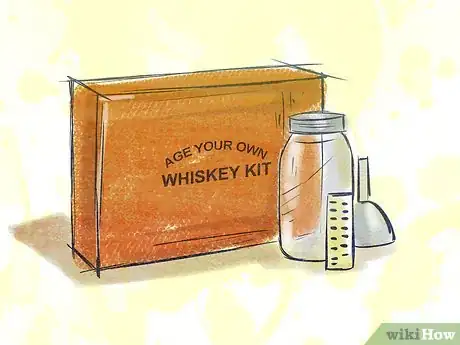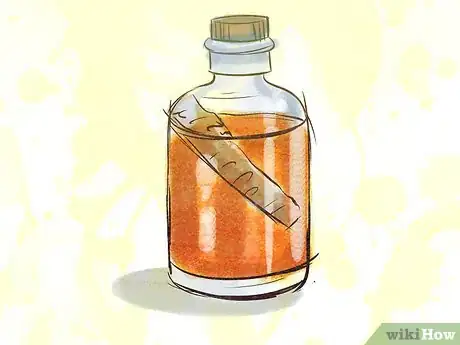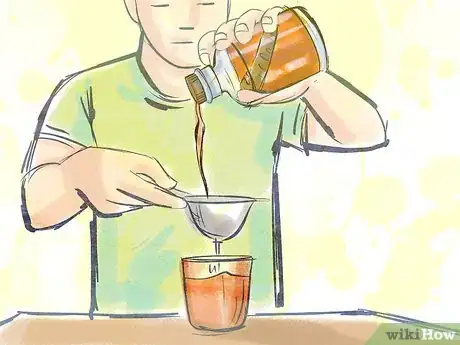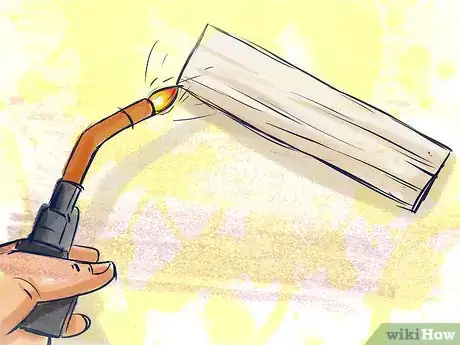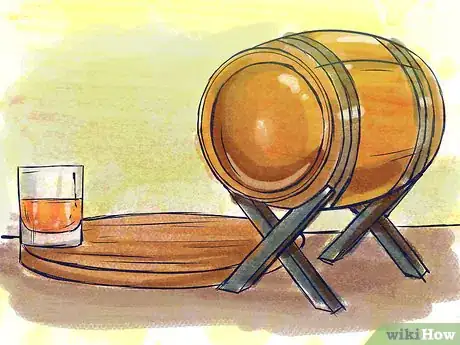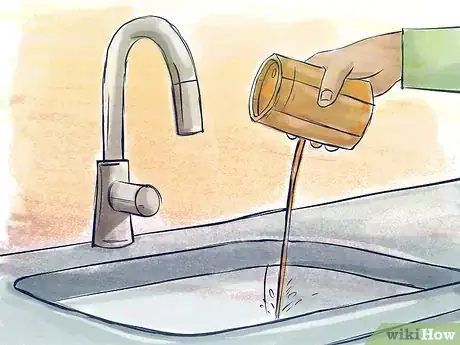X
This article was co-authored by Tom Blake. Tom Blake manages the bartending blog, craftybartending.com. He has been a bartender since 2012 and has written a book named The Bartender's Field Manual.
This article has been viewed 23,452 times.
Companies age their whiskey for years to get small batches of the highest quality product. Because of this, aged whiskey can be expensive to get from the store. At home, you can create aged whiskey in a fraction of the time. Get a bottle or two of an unaged, high proof whiskey. Combine the whiskey with oak strips or an oak barrel, and store it out of direct sunlight. Wait weeks or months for the whiskey to age and you'll end up with a drink you can be proud to taste.
Steps
Part 1
Part 1 of 3:
Using an Aging Kit
-
1Buy the kit. DIY kits come with all the tools you need to age your own whiskey at home, such as charred wood. They work quicker than other options and function as a more hands-off approach to aging whiskey. You won't need to char wood or store a barrel.[1]
- DIY kits can be bought online and may also be found in some brewing supply stores. You will need to buy your own whiskey.
-
2Add the wood to unaged whiskey. Find the oak staves in the package. Typically, the directions will indicate that you need 1 stave for every 350 mL (12 oz) of whiskey. For a standard bottle, you'll need both pieces of oak in the kit. Drop the oak into the bottle.
- Corn-based whiskey will produce bourbon-style whiskey, while barley-based whiskey will produce something similar to Irish Canadian or unpeated Scotch whiskey.
Advertisement -
3Store the whiskey away from direct sunlight. Sunlight will affect the taste of the whiskey. Store the bottle in a cupboard, closet, or similar area at room temperature. Slight changes in temperature will cause the wood to expand and contract, infusing the whiskey with its flavor.
-
4Test the whiskey as it ages. The oak will rapidly change the taste of the whiskey. You'll notice the whiskey change color within a day or 2. The kit may come with an aging guide, which will recommend a very brief aging period of about a week or 2. After this point, the whiskey may taste too woody.
-
5Strain the whiskey before drinking. If the kit comes with cheesecloth, you can use it to strain out any charred flecks of wood. Place the cheesecloth over your glass so the whiskey doesn't spill. Pour the whiskey over it. Remove the cheesecloth along with the collected debris.
Advertisement
Part 2
Part 2 of 3:
Aging Whiskey with Charred Wood Strips
-
1Split a piece of oak into strips. Bring along the whiskey bottle or mason jar you'll use to age the whiskey. You need to shorten the wood so that it'll fit inside the jar. Split the wood into a thin stick. The wood will expand during the aging process, so don't be afraid to cut the wood very thin or even break the stick into a few strips.
- White oak is used by professionals to age whiskey. If you can't get oak, you can try another non-poisonous, chemical-free wood such as maple, cherry, or birch.[2]
- Get fresh oak from brewing supply stores and home improvement stores. Old oak can also be scavenged sources such as old furniture.
-
2Char the wood with a blowtorch or grill. Take protective precautions by wearing gloves and goggles. Hold the wood in place over the open flame. The temperature you use will change the flavor the wood gives the whiskey. 250-360℉ (121-182℃) creates a sweet, oaky combination. 380-480℉ (193-249℃) leads to a vanilla, toasted flavor. Char the wood until it appears black and shiny on all sides.[3]
- You can also bake the wood before you char. This can help you get the right flavor profile without depending on charring at the right temperature. Simply let the wood bake in an oven at the desired temperature for 3 hours before charring.
- Brewing supply shops also sell pre-charred oak chips.
-
3Wash off the wood. Wait for the wood to feel cool to the touch. Keep on the protective gloves or pick up the wood with tongs to protect yourself. Rinse the wood under lukewarm water. Wipe down the wood with a cloth to remove ash and other debris that could get into the whiskey.[4]
-
4Combine the wood and whiskey. Place the ingredients into the mason jar or simply add the wood to the whiskey bottle. An average, unaged whiskey works best here. Opt for whiskey of proof 115 or higher, if possible. Higher proof whiskey tends to age better and is used by whiskey companies in their products.
-
5Store the jar in a dark place. Now you must wait for the whiskey to age. Ideally, store the jar in a place where the temperature changes, such as outdoors. Warm days and cool nights cause the wood to change size. Keep the jar out of direct sunlight. At home, you can leave it in a closet, a garage, or a similar area.
-
6Test the whiskey weekly. Though the small container size means the whiskey will age faster, it'll still take several weeks to a year to get the flavor you desire. Set up a testing schedule to make sure the whiskey doesn't over-age. Early on, your batch will likely taste terrible and woody, but stick with it. The pleasant flavors will eventually come out.
Advertisement
Part 3
Part 3 of 3:
Aging Whiskey in a Barrel
-
1Get an oak barrel. Barrels can be found online or in brewing supply stores. They come in all sizes, from small, liter-sized barrels to big tanks used by commercial manufacturers. Smaller barrels are easier to use and smaller batches of whiskey age faster.
- Look for charred white oak barrels. This is the kind of wood used by the professionals. You may also char the inside of the barrel yourself with a blowtorch.
-
2Assemble the barrel. Find the spigot, which looks like a faucet. Set it in the hole you'll see on one of the flat ends of the barrel. Next, get the bung, which looks like a cork. Place it nearby.
-
3Fill the barrel with water. If you have a funnel, you can set it in the bunghole, which will be on the rounded midsection of the barrel. Pour in enough water to fill the barrel. Plug the bunghole with the bung. Turn on the spigot for a moment to see if water flows. Afterward, check the rest of the barrel for leaks. Leave the barrel alone until it stops leaking.[5]
- It can take a day or more for the barrel to stop leaking.
- You'll have to do this process before every use. When the barrel is not in use, keep water in it to save time.
-
4Drain the water and replace it with whiskey. Get enough whiskey to fill the barrel. For a small barrel, you'll need a bottle or 2. Opt for an unaged or younger whiskey. Higher proof whiskey ages better, so aim for a proof of 90 or higher.[6]
-
5Store the barrel in a dark environment. Keep the barrel in a closet, cellar, shed, or another area away from direct sunlight. Temperature changes can help the whiskey mature faster, as they cause the wood to shrink and expand. Spray the barrel with water or pass a damp cloth over it when it looks dry. This will protect the barrel and limit evaporation as the whiskey ages.
-
6Test the whiskey over time. Smaller barrels of whiskey will age faster. Typically, a 1- or 2-liter batch will be done in a month or 2. The biggest barrels can take several years. Barrels can be used several times, but will take longer to age the whiskey each time.[7]
- The longer you age the whiskey, the more you'll lose to evaporation.
-
7Strain and bottle the whiskey. Once the whiskey's taste is to your liking, remove it from the barrel. You can pour it out 1 glass at a time as you strain it. Straining is good for removing char and wood pieces. Place a cheesecloth over a mason jar or other storage container. Pour the whiskey over the cheesecloth. Remove the cheesecloth and the debris it has collected.
Advertisement
Community Q&A
-
QuestionHow long can you age whiskey like this?
 lex oooCommunity AnswerYou can age your whiskey for some weeks or months. However, it all depends on the taste you are looking for.
lex oooCommunity AnswerYou can age your whiskey for some weeks or months. However, it all depends on the taste you are looking for. -
QuestionDo I cover the jar with the top on or a cloth?
 Community AnswerCover the jar with the top on the jar.
Community AnswerCover the jar with the top on the jar.
Advertisement
Things You'll Need
Aging in a Jar
- Oak piece
- Saw or knife
- Blowtorch or grill
- Small mason jar
- High proof whiskey
Aging in a Barrel
- Oak barrel
- Water
- Several bottles of high proof whiskey
- Cheesecloth
References
- ↑ https://www.tastingtable.com/drinks/national/homemade-whiskey-how-to-age-whiskey-at-home
- ↑ http://www.whiskyhead.com/whisky-aging.htm
- ↑ http://www.whiskyhead.com/whisky-aging.htm
- ↑ http://www.whiskyhead.com/whisky-aging.htm
- ↑ http://whiskeytangoglobetrot.com/adventures-in-learning-to-barrel-age-my-own-whiskey/
- ↑ http://www.dcfoodies.com/2011/02/barrel-aging-whiskey-at-home-because-you-have-too-much-time-on-your-hands.html
- ↑ http://whiskeytangoglobetrot.com/adventures-in-learning-to-barrel-age-my-own-whiskey/
About This Article
Advertisement
